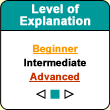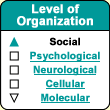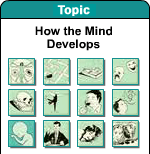|
|
|
|
 |
| From Embryo to Ethics |
 |
|
|
|

 |
 |
 |

 |
 |
The story of “Heinz’s
moral dilemma” is a classic example of the kinds of
problems that Kohlberg posed to his subjects. Here is a brief
version.
Heinz’s wife was very ill. Unless she could get a certain
medicine, she could die at any time. But this medicine was
very expensive, and Heinz could not afford it. He went to the
druggist anyway and asked if he could have the medicine more
cheaply, or even on credit. The druggist refused. What should
Heinz do: let his wife die, or steal the drug?
What interested Kohlberg was not so much the response that
each of his subjects provided as the reasoning behind it. Different
subjects might choose the same solution to Heinz’s moral
dilemma, but for different reasons that revealed the differing
foundations of their moral thinking.
For example, one child might say that Heinz had to let his
wife die so that he would not go to prison, while another might
say that Heinz had to steal the drug, because otherwise God
would punish him for having let his wife die. Or one adult
might say that Heinz had to let his wife die because stealing
is against the law, while another adult might say that Heinz
had to steal the medicine because failing to help someone who
is in danger is punishable by law. Despite their differing
answers, both adults would be displaying conventional moral
reasoning characteristic of Kohlberg’s stage 4.
|
|
|
Inspired by the work of Jean
Piaget, developmental psychologist Lawrence Kohlberg was one
of the first researchers to study the moral development of the individual.
Kohlberg presented his experimental subjects with moral dilemmas
in the form of little stories, then asked them to make moral judgments
about the behaviour of the main character in each story. By analyzing
the reasons that the subjects gave for their judgments (more than
the judgments themselves), Kohlberg identified three
major levels of moral judgment, each of which he divided into
two stages, for a total of six successive stages in which each individual
takes increasing account of other people in his or her decisions
about how to behave.
The first two stages, at level
1, preconventional morality, occur before the
individual has even become aware of social conventions.
At stage 1 (from about age 2 or 3 to
about age 5 or 6), children seek mainly to avoid the punishment
that authority figures such as their parents can mete out.to
them |
|
| |
|
| At stage 2 (from
age 5 to age 7, or up to age 9, in some cases), children learn
that it is in their interest to behave well, because rewards
are in store if they do. |
|
| |
|
The next two stages occur at level
2, conventional morality—so named because
at these stages it is no longer individuals such as parents,
but rather social groups, such as family and friends, that
children perceive as the source of authority.
At stage 3 (from about age 7 to about
age 12), children feel the need to satisfy the expectations
of the other members of their group. In so doing, children
seek to preserve rules that will lead to predictable behaviour. |
|
| |
|
| At stage 4 (from age
10 to age 15, on average), the conventions that guide the individual’s
behaviour expand to include those of the society in which he
or she lives. In examining the justification for a given course
of action, the individual considers whether it is consistent
with the norms and laws of this society. |
|
| |
|
Level 3, postconventional
morality, is so named because in the last two
stages, which it comprises, the individual’s morality
goes beyond the frame of reference of any one particular
society.
At stage 5 (starting as early as age
12, in some cases), individuals feel as if they have freely
entered into a contractual commitment with every person
around them. This commitment is based on a desire for consensus
and a rational assessment of the benefits that everyone
can derive from the existence of these rules. |
|
| |
|
| At stage 6, individuals’ judgments
of good and bad become influenced by universal moral principles.
People at stage 6 agree that laws and societal values have
a certain validity, but if these laws conflict with their own
principles of human dignity, they will follow these principles,
which they regard as an internally imposed imperative. |
|
According to Kohlberg, people go through these six stages in the
above order: most children have a preconventional morality, and
most adults have a conventional one. Kohlberg estimated that only
20 to 25% of the adult population attains the postconventional
level of morality.
Somewhat later in his career, Kohlberg described stage 7, the “mystic stage”,
which he regarded as meta-ethical: in this stage, individuals become capable
of problematizing any action or intention by asking themselves why it might be
moral.
Kohlberg’s model of moral development, though
it can be criticized in many respects, is valuable in that it focuses on
certain central issues that individuals must address in constructing their relationships
with others.
A study was conducted
of 183 political resisters in such areas as antinuclear politics
and tax resistance. Compared with non-resisters, these individuals
rejected social and political authority more strongly and
believed that individual conscience was a better guide to
conduct than the law was. These moral perspectives thus placed
them at Kohlberg’s stages 5 and 6. In comparison, conservatives
were mainly at stage 4, and liberals at stage 5. |
|
|










